The Impact of Climate on Siberian Cat Health and Well-being
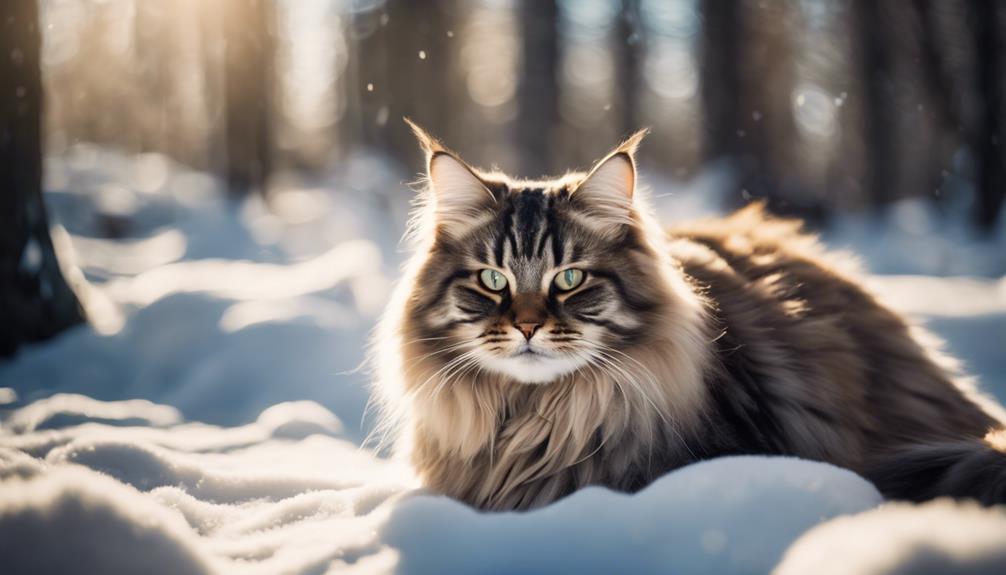
The Siberian cat breed is known for its thick, triple-layered coat that helps protect it from harsh winter conditions in its native Siberia. This thick coat also makes Siberian cats more susceptible to heat stress in warmer climates, as they may struggle to regulate their body temperature effectively.
Climate can also impact the prevalence of certain health conditions in Siberian cats. For example, respiratory issues may be more common in humid or polluted environments, while skin conditions could be exacerbated in dry or dusty climates.
Overall, it's important for Siberian cat owners to be aware of how climate can affect their pet's health and to take precautions to ensure their well-being in any environment.
Climate's Influence on Siberian Cat Health
In cold climates, Siberian cats' health is intricately influenced by the adaptation of their thick winter coat, essential for insulation and protection against harsh weather conditions. The balance of their diet plays a crucial role in supporting the maintenance of this coat. Siberian cats living in colder regions naturally undergo a seasonal change where their summer coat is shed to make way for a thicker winter coat. This process is triggered by the cold weather, ensuring they're well-prepared for the harsh conditions they'll face.
Therefore, it's vital for cat owners to provide a balanced diet that supports the growth and maintenance of their Siberian cat's coat. Ensuring they receive adequate nutrition helps them stay healthy and maintain their protective fur barrier against the cold. By understanding the seasonal changes and the impact on their feline companion's well-being, cat owners can take proactive steps to support their beloved pets through the changing climate.
Seasonal Changes and Feline Well-being
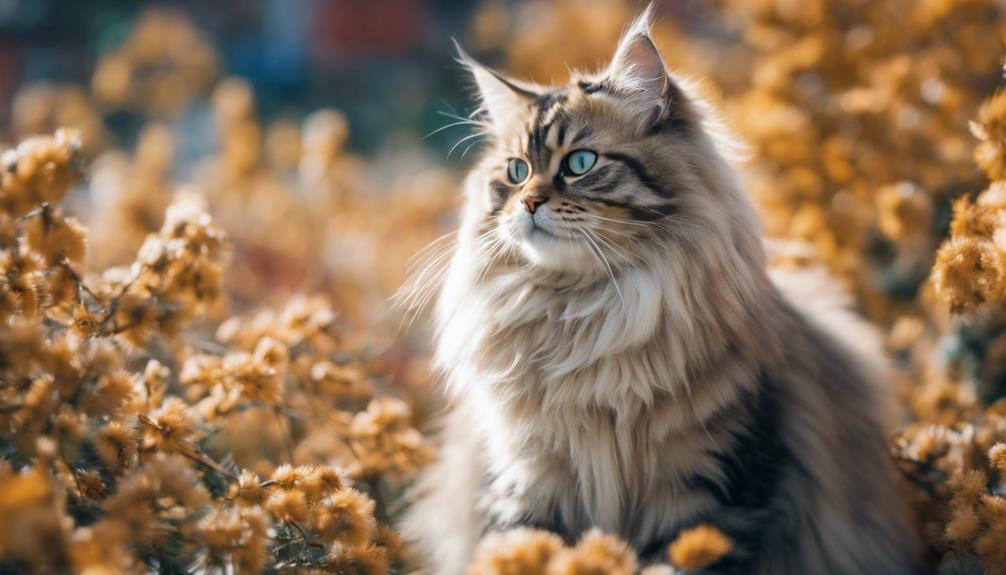
Ensuring Siberian cats' well-being during seasonal changes involves understanding their unique fur adaptations and providing necessary warmth and shelter for their comfort and health. Siberian cats, a cold-weather cat breed, have thick, water-resistant coats that naturally thicken in colder months to enhance insulation. To cater to their needs, creating a cozy indoor environment with comfortable temperatures is crucial, especially when outdoor conditions are harsh. Additionally, offering stimulating indoor environments like cat trees can help keep them active and engaged during colder seasons when outdoor activities may be limited.
| Aspect | Details |
|---|---|
| 1. Fur Adaptations | Siberian cats have thick, water-resistant coats that naturally adjust to provide insulation. |
| 2. Indoor Comfort | Maintaining a warm indoor environment and providing stimulating activities like cat trees is essential. |
| 3. Outdoor Exposure | Monitoring outdoor access and limiting exposure during extreme cold is vital for their safety. |
| 4. Flea Prevention | Regular flea treatment is crucial year-round, especially during seasonal changes, for optimal well-being. |
Impact of Extreme Temperatures on Cats
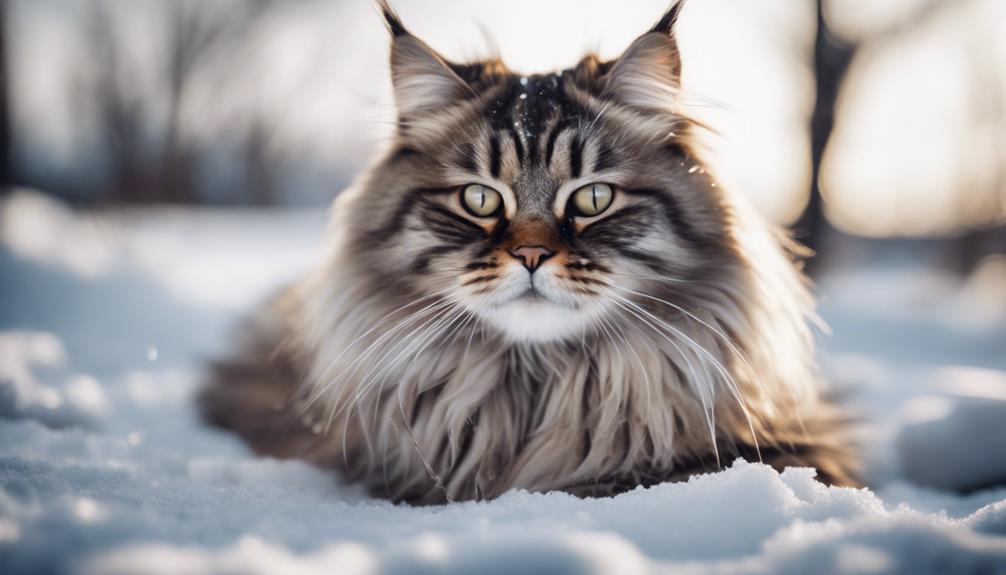
Understanding the impact of extreme temperatures on cats is crucial for ensuring their comfort and well-being. Extreme heat or cold can significantly affect Siberian cats, leading to discomfort and potential health risks like heatstroke or hypothermia.
In very hot conditions, cats may become lethargic, seek cool areas, and be at risk of dehydration. Conversely, in extreme cold, cats may shiver, have reduced activity levels, and struggle to stay warm.
To safeguard cats from these dangers, make sure they've access to adequate shelter, clean water, and a climate-controlled environment. Monitoring indoor temperatures and providing proper insulation in outdoor shelters are essential steps to protect cats from temperature extremes.
Weather Patterns and Cat Behavior
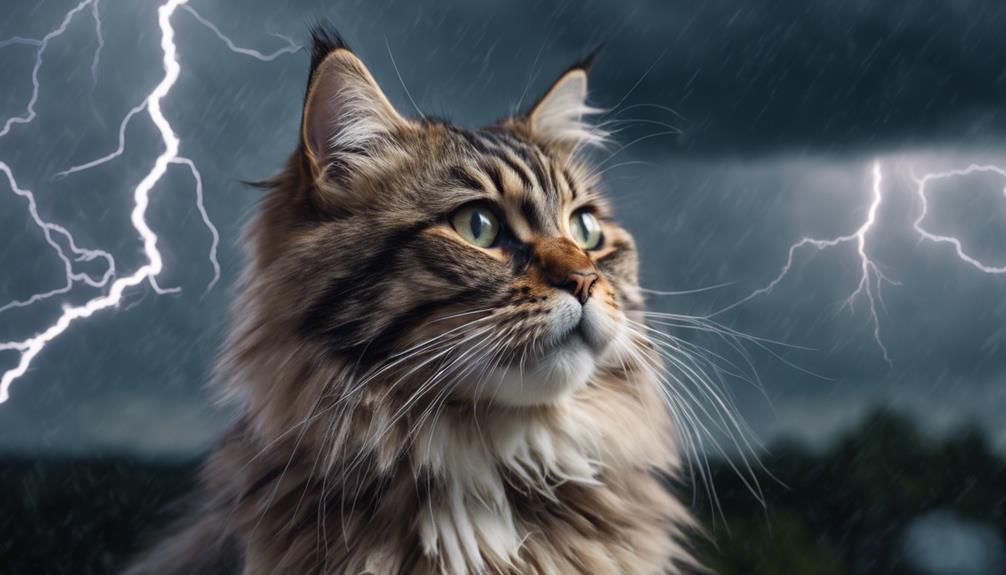
As weather patterns shift, Siberian cats may adapt their behavior to seek warmth and maintain their energy levels during colder seasons. When the temperature drops, these majestic felines display unique behavior patterns influenced by the weather. Here are some key insights into how weather can impact Siberian cat behavior:
- Adapting Playfulness: Siberian cats may exhibit increased playfulness and activity during colder weather to stay warm and energized.
- Indoor Activities: Changes in weather patterns can lead to more indoor activities for Siberian cats during extreme cold, affecting their mood and behavior.
- Seeking Warmth: When temperatures decrease significantly, cats may actively seek out warmer areas in the house or near heat sources to keep cozy.
Understanding how weather influences feline habits is crucial for ensuring the well-being of Siberian cats. By recognizing these climate impacts on cat activity, owners can provide the necessary warmth and comfort to keep their beloved pets happy and healthy.
Adapting Siberian Cats to Climate Variations
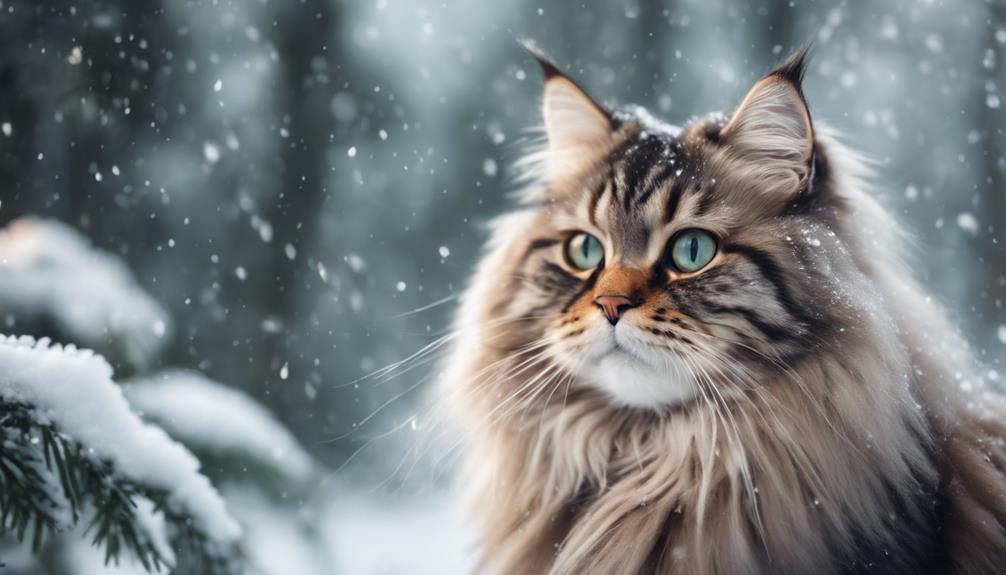
Siberian cats possess remarkable natural adaptations to varying climates. Their dense, water-resistant undercoat acts as a shield against cold weather. Their shedding patterns, dictated by the length of daylight, aid in transitioning smoothly between seasons.
To help indoor Siberian cats acclimate comfortably to outdoor chilliness, gradual exposure to colder temperatures is essential for their well-being.
Climate and Cat Health
When adapting Siberian cats to climate variations, ensuring they have adequate warmth, food, shelter, and training for using pet doors is essential for their well-being. Siberian cats naturally adjust to changing temperatures through mechanisms like coat shedding, cold resistance, and indoor acclimatization.
To help them thrive in varying climates, consider the following:
- Regular grooming to assist in the shedding process and maintain their coat's insulating properties.
- Providing cozy spots or heated beds to keep them warm during colder weather.
- Introducing outdoor exposure gradually to help them acclimatize to the cold and ensuring they have dry conditions to prevent chilling.
Temperature Adaptation Strategies
Developing a thicker winter coat with increased undercoat, Siberian cats naturally adapt to temperature variations to enhance their cold resistance and protect themselves in harsh weather conditions. This fur thickness and seasonal shedding process help regulate their body temperature, allowing them to thrive in cold climates. The thick undercoat of Siberian cats has waterproof properties that further aid in their cold resistance, keeping them dry and warm. Gradual acclimatization to outdoor cold, ensuring dryness, and providing access to warmth and shelter are crucial steps in helping these cats adjust to changing temperatures. Training them to use pet doors can also facilitate their transition between indoor warmth and outdoor cold.
| Temperature Adaptation Strategies | Benefits |
|---|---|
| Fur thickness | Enhanced cold resistance and protection |
| Seasonal shedding | Regulating body temperature |
| Cold resistance | Waterproof undercoat for insulation |
Environmental Factors Affecting Cat Health

Considering the intricate connection between environmental conditions and feline well-being, it's crucial to acknowledge how various factors can significantly impact the health of cats.
- Coat Thickness Regulation, Grooming Needs: Environmental factors like temperature fluctuations play a key role in regulating the coat thickness of Siberian cats, affecting their grooming requirements.
- Indoor Temperature Adjustments, Weather Elements: Extreme weather conditions may prompt adjustments in indoor temperature settings to ensure the comfort and well-being of Siberian cats, especially in harsh climates.
- Humidity Levels, Skin Condition Maintenance: Monitoring humidity levels is vital as it directly impacts the skin and coat condition of Siberian cats, requiring careful attention to maintain their health.
Understanding and managing these environmental factors can help cat owners ensure that their Siberian companions thrive regardless of the climate challenges they may face. By being attentive to these elements, caregivers can provide a safe and comfortable environment for their beloved feline friends.
Ensuring Siberian Cat Wellness in Any Climate
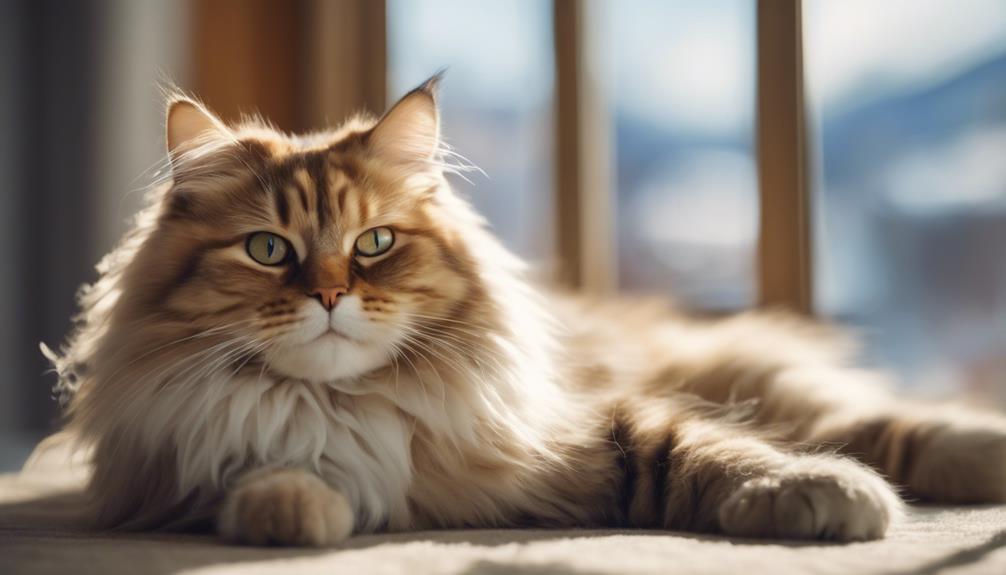
Siberian cat owners can ensure their feline companions' wellness in any climate by understanding the impact of weather conditions on their health. Tips such as monitoring hydration, providing adequate shade, and adjusting grooming routines are essential for Siberians to thrive in varying environments.
Climate and Cat Health
Ensuring optimal wellness for Siberian cats in any climate involves understanding and addressing the impact of environmental factors on their health.
- Coat maintenance: Regular grooming practices are essential for temperature regulation and overall coat health.
- Weather impact: Monitoring humidity levels and adjusting grooming practices according to seasonal changes help maintain the Siberian cat's coat condition.
- Indoor comfort: Providing a climate-controlled environment ensures the Siberian cat's well-being, regardless of external weather conditions.
Wellness Tips for Siberians
With a focus on holistic care, maintaining the wellness of Siberian cats in any climate involves implementing a combination of grooming, environmental enrichment, and dietary strategies. Regular grooming sessions are essential for managing shedding and keeping the Siberian cat's coat healthy.
Providing mental stimulation through interactive toys and puzzles is crucial for their overall well-being. Monitoring indoor temperatures to ensure comfort is key, adjusting settings as needed to promote optimal health. Incorporating scratching posts and cat trees satisfies their natural instincts and encourages healthy behavior.
Offering a balanced diet with appropriate portions supports their energy needs and weight management. By focusing on coat care, shedding management, mental stimulation, interactive play, temperature regulation, and comfort monitoring, Siberian cats can thrive in any environment.
Adaptation to Environments
As Siberian cats adapt naturally to diverse climates, their resilience to temperature variations underscores the importance of providing proper shelter and care to ensure their overall wellness in any environment. Siberian cats' fur insulation, climate resilience, and environmental adaptation play key roles in their ability to thrive in different settings.
- Fur Insulation: The thick, waterproof undercoat of Siberian cats provides excellent insulation against cold and wet conditions, helping them stay comfortable in various climates.
- Climate Resilience: Siberian cats are known for their ability to regulate body temperature effectively, making them resilient in facing diverse environmental challenges.
- Environmental Adaptation: Providing adequate shelter, warmth, and indoor spaces during extreme weather conditions is crucial for supporting Siberian cats' environmental adaptation and overall well-being.
Frequently Asked Questions
Do Siberian Cats Do Well in Hot Weather?
Siberian cats may struggle in hot weather due to their thick fur. Owners should offer shade, cool spots, and water to help them stay comfortable. Monitoring grooming needs, hydration, and limiting sun exposure are crucial.
Do Siberian Cats Have Health Issues?
Siberian cats are generally healthy with no breed-specific health issues. Regular veterinary check-ups, weight monitoring, and proper grooming are vital. Managing allergies, exercise, dental care, and parasite prevention are crucial for their well-being and longevity.
How Cold Is Too Cold for Siberian Cats?
When considering how cold is too cold for Siberian cats, it's essential to provide indoor shelters with proper insulation. Preventing frostbite is crucial. Monitoring signs like shivering guides responsible care for these resilient felines.
What Is the Life Expectancy of a Siberian Cat?
Siberian cats generally have an average lifespan of 12 to 15 years, influenced by genetic factors and environmental conditions. Proper care, weight management, and regular veterinary visits are vital for ensuring the longevity and well-being of these beloved felines.











